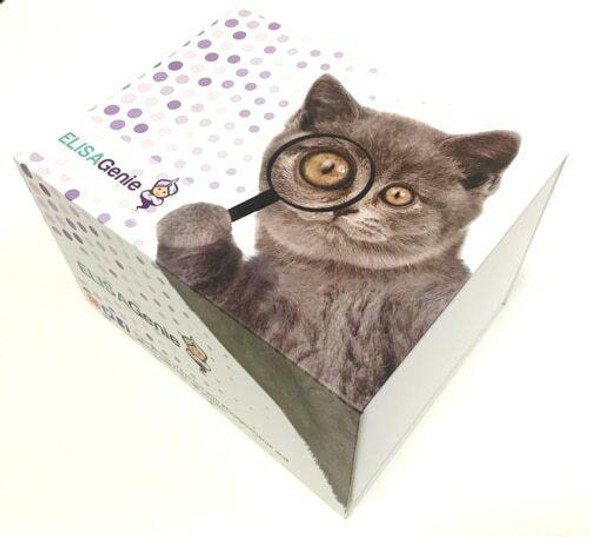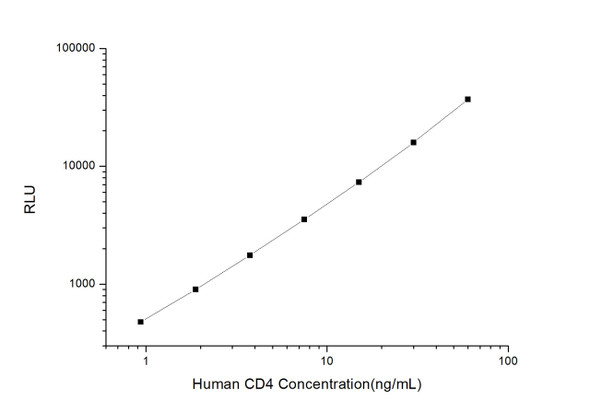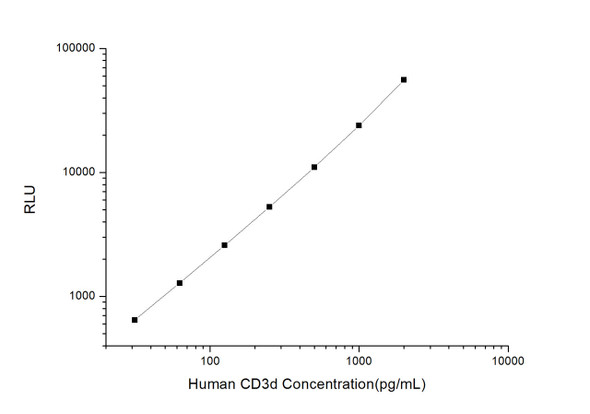Human Cell Biology ELISA Kits 5
Human CD276 (Cluster of Differentiation 276) CLIA Kit (HUES00843)
- SKU:
- HUES00843
- Product Type:
- ELISA Kit
- ELISA Type:
- CLIA Kit
- Size:
- 96 Assays
- Sensitivity:
- 0.09ng/mL
- Range:
- 0.16-10ng/mL
- ELISA Type:
- Sandwich
- Synonyms:
- B7-H3, B7H3, B7RP-2, 4Ig-B7-H3
- Reactivity:
- Human
- Sample Type:
- Serum, plasma and other biological fluids
- Research Area:
- Cell Biology
Description
| Assay type: | Sandwich |
| Format: | 96T |
| Assay time: | 4.5h |
| Reactivity: | Human |
| Detection method: | Chemiluminescence |
| Detection range: | 0.16-10 ng/mL |
| Sensitivity: | 0.09 ng/mL |
| Sample volume: | 100µL |
| Sample type: | Serum, plasma and other biological fluids |
| Repeatability: | CV < 15% |
| Specificity: | This kit recognizes Human CD276 in samples. No significant cross-reactivity or interference between Human CD276 and analogues was observed. |
This kit uses Sandwich-CLIA as the method. The micro CLIA plate provided in this kit has been pre-coated with an antibody specific to Human CD276. Standards or samples are added to the appropriate micro CLIA plate wells and combined with the specific antibody. Then a biotinylated detection antibody specific for Human CD276 and Avidin-Horseradish Peroxidase (HRP) conjugate are added to each micro plate well successively and incubated. Free components are washed away. The substrate solution is added to each well. Only those wells that contain Human CD276, biotinylated detection antibody and Avidin-HRP conjugate will appear fluorescence. The Relative light unit (RLU) value is measured spectrophotometrically by the Chemiluminescence immunoassay analyzer. The RLU value is positively associated with the concentration of Human CD276. The concentration of Human CD276 in the samples can be calculated by comparing the RLU of the samples to the standard curve.
| UniProt Protein Function: | CD276: May participate in the regulation of T-cell-mediated immune response. May play a protective role in tumor cells by inhibiting natural-killer mediated cell lysis as well as a role of marker for detection of neuroblastoma cells. May be involved in the development of acute and chronic transplant rejection and in the regulation of lymphocytic activity at mucosal surfaces. Could also play a key role in providing the placenta and fetus with a suitable immunological environment throughout pregnancy. Both isoform 1 and isoform 2 appear to be redundant in their ability to modulate CD4 T-cell responses. Isoform 2 is shown to enhance the induction of cytotoxic T-cells and selectively stimulates interferon gamma production in the presence of T-cell receptor signaling. Belongs to the immunoglobulin superfamily. BTN/MOG family. 4 isoforms of the human protein are produced by alternative splicing. |
| UniProt Protein Details: | Protein type:Membrane protein, integral Chromosomal Location of Human Ortholog: 15q23-q24 Cellular Component: external side of plasma membrane; integral to membrane Molecular Function:protein binding; receptor binding Biological Process: cell proliferation; immune response; negative regulation of inflammatory response; negative regulation of interferon-gamma biosynthetic process; negative regulation of interleukin-2 biosynthetic process; negative regulation of T cell proliferation; positive regulation of bone mineralization; positive regulation of interferon-gamma biosynthetic process; positive regulation of osteoblast differentiation; positive regulation of T cell proliferation; regulation of immune response; T cell activation |
| NCBI Summary: | The protein encoded by this gene belongs to the immunoglobulin superfamily, and thought to participate in the regulation of T-cell-mediated immune response. Studies show that while the transcript of this gene is ubiquitously expressed in normal tissues and solid tumors, the protein is preferentially expressed only in tumor tissues. Additionally, it was observed that the 3' UTR of this transcript contains a target site for miR29 microRNA, and there is an inverse correlation between the expression of this protein and miR29 levels, suggesting regulation of expression of this gene product by miR29. Alternatively spliced transcript variants encoding different isoforms have been found for this gene. [provided by RefSeq, Sep 2011] |
| UniProt Code: | Q5ZPR3 |
| NCBI GenInfo Identifier: | 74757248 |
| NCBI Gene ID: | 80381 |
| NCBI Accession: | Q5ZPR3. 1 |
| UniProt Secondary Accession: | Q5ZPR3,Q6P5Y4, Q6UXI2, Q8NBI8, Q8NC34, Q8NCB6, Q9BXR1 |
| UniProt Related Accession: | Q5ZPR3 |
| Molecular Weight: | |
| NCBI Full Name: | CD276 antigen |
| NCBI Synonym Full Names: | CD276 molecule |
| NCBI Official Symbol: | CD276 |
| NCBI Official Synonym Symbols: | B7H3; B7-H3; B7RP-2; 4Ig-B7-H3 |
| NCBI Protein Information: | CD276 antigen |
| UniProt Protein Name: | CD276 antigen |
| UniProt Synonym Protein Names: | 4Ig-B7-H3; B7 homolog 3; B7-H3; Costimulatory molecule; CD_antigen: CD276 |
| Protein Family: | CD276 antigen |
| UniProt Gene Name: | CD276 |
| UniProt Entry Name: | CD276_HUMAN |
As the RLU values of the standard curve may vary according to the conditions of the actual assay performance (e. g. operator, pipetting technique, washing technique or temperature effects), the operator should establish a standard curve for each test. Typical standard curve and data is provided below for reference only.
| Concentration (ng/mL) | RLU | Average | Corrected |
| 10 | 31138 33804 | 32471 | 32447 |
| 5 | 14367 16573 | 15470 | 15446 |
| 2.5 | 8075 6931 | 7503 | 7479 |
| 1.25 | 3554 3752 | 3653 | 3629 |
| 0.63 | 1848 1674 | 1761 | 1737 |
| 0.31 | 860 788 | 824 | 800 |
| 0.16 | 357 357 | 357 | 333 |
| 0 | 24 24 | 24 | -- |
Precision
Intra-assay Precision (Precision within an assay): 3 samples with low, mid range and high level Human CD276 were tested 20 times on one plate, respectively.
Inter-assay Precision (Precision between assays): 3 samples with low, mid range and high level Human CD276 were tested on 3 different plates, 20 replicates in each plate.
| Intra-assay Precision | Inter-assay Precision | |||||
| Sample | 1 | 2 | 3 | 1 | 2 | 3 |
| n | 20 | 20 | 20 | 20 | 20 | 20 |
| Mean (ng/mL) | 0.51 | 1.06 | 3.88 | 0.49 | 1.12 | 3.86 |
| Standard deviation | 0.04 | 0.12 | 0.28 | 0.06 | 0.09 | 0.25 |
| C V (%) | 7.84 | 11.32 | 7.22 | 12.24 | 8.04 | 6.48 |
Recovery
The recovery of Human CD276 spiked at three different levels in samples throughout the range of the assay was evaluated in various matrices.
| Sample Type | Range (%) | Average Recovery (%) |
| Serum (n=5) | 94-109 | 99 |
| EDTA plasma (n=5) | 92-104 | 98 |
| Cell culture media (n=5) | 99-112 | 105 |
Linearity
Samples were spiked with high concentrations of Human CD276 and diluted with Reference Standard & Sample Diluent to produce samples with values within the range of the assay.
| Serum (n=5) | EDTA plasma (n=5) | Cell culture media (n=5) | ||
| 1:2 | Range (%) | 102-116 | 89-102 | 94-107 |
| Average (%) | 108 | 95 | 101 | |
| 1:4 | Range (%) | 91-107 | 90-103 | 95-109 |
| Average (%) | 98 | 96 | 101 | |
| 1:8 | Range (%) | 95-106 | 91-102 | 93-109 |
| Average (%) | 100 | 96 | 101 | |
| 1:16 | Range (%) | 102-114 | 96-112 | 94-106 |
| Average (%) | 108 | 102 | 100 |
An unopened kit can be stored at 4°C for 1 month. If the kit is not used within 1 month, store the items separately according to the following conditions once the kit is received.
| Item | Specifications | Storage |
| Micro CLIA Plate(Dismountable) | 8 wells ×12 strips | -20°C, 6 months |
| Reference Standard | 2 vials | |
| Concentrated Biotinylated Detection Ab (100×) | 1 vial, 120 µL | |
| Concentrated HRP Conjugate (100×) | 1 vial, 120 µL | -20°C(shading light), 6 months |
| Reference Standard & Sample Diluent | 1 vial, 20 mL | 4°C, 6 months |
| Biotinylated Detection Ab Diluent | 1 vial, 14 mL | |
| HRP Conjugate Diluent | 1 vial, 14 mL | |
| Concentrated Wash Buffer (25×) | 1 vial, 30 mL | |
| Substrate Reagent A | 1 vial, 5 mL | 4°C (shading light) |
| Substrate Reagent B | 1 vial, 5 mL | 4°C (shading light) |
| Plate Sealer | 5 pieces | |
| Product Description | 1 copy | |
| Certificate of Analysis | 1 copy |
- Set standard, test sample and control (zero) wells on the pre-coated plate and record theirpositions. It is recommended to measure each standard and sample in duplicate. Note: addall solutions to the bottom of the plate wells while avoiding contact with the well walls. Ensuresolutions do not foam when adding to the wells.
- Aliquot 100µl of standard solutions into the standard wells.
- Add 100µl of Sample / Standard dilution buffer into the control (zero) well.
- Add 100µl of properly diluted sample (serum, plasma, tissue homogenates and otherbiological fluids. ) into test sample wells.
- Cover the plate with the sealer provided in the kit and incubate for 90 min at 37°C.
- Aspirate the liquid from each well, do not wash. Immediately add 100µL of BiotinylatedDetection Ab working solution to each well. Cover the plate with a plate seal and gently mix. Incubate for 1 hour at 37°C.
- Aspirate or decant the solution from the plate and add 350µL of wash buffer to each welland incubate for 1-2 minutes at room temperature. Aspirate the solution from each well andclap the plate on absorbent filter paper to dry. Repeat this process 3 times. Note: a microplatewasher can be used in this step and other wash steps.
- Add 100µL of HRP Conjugate working solution to each well. Cover with a plate seal andincubate for 30 min at 37°C.
- Aspirate or decant the solution from each well. Repeat the wash process for five times asconducted in step 7.
- Add 100µL of Substrate mixture solution to each well. Cover with a new plate seal andincubate for no more than 5 min at 37°C. Protect the plate from light.
- Determine the RLU value of each well immediately.






